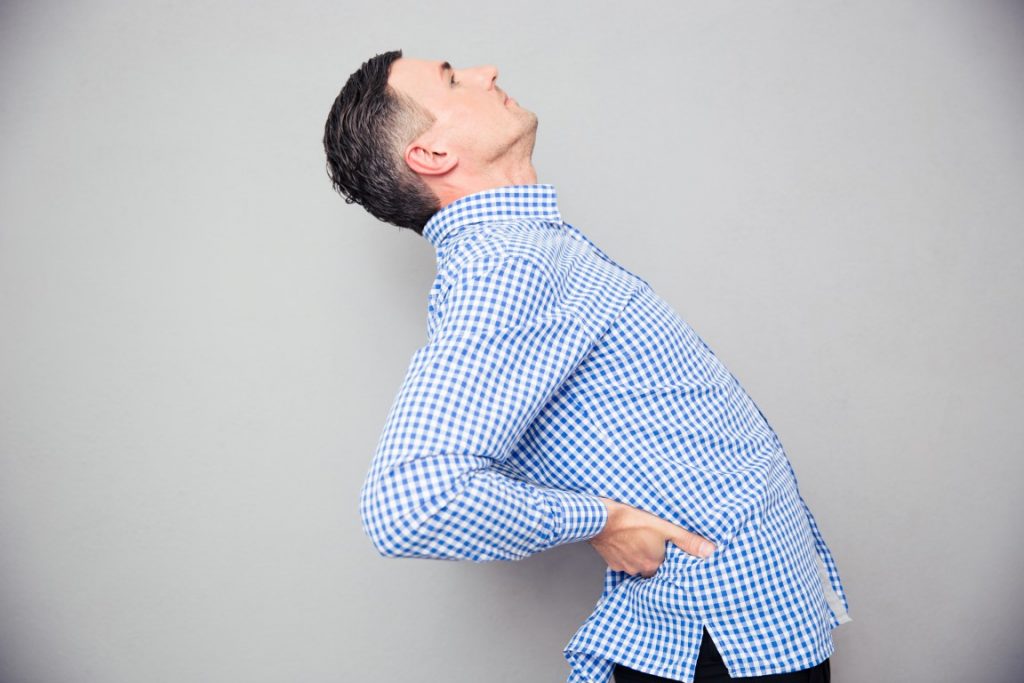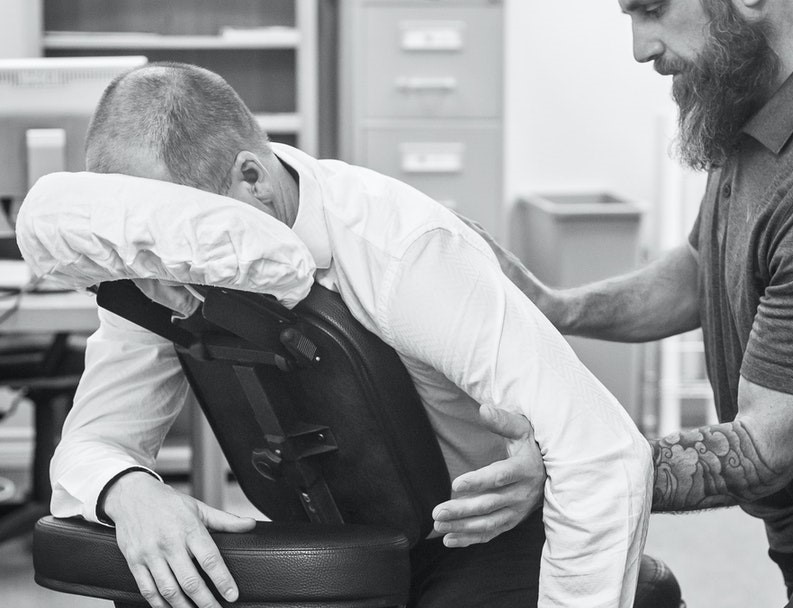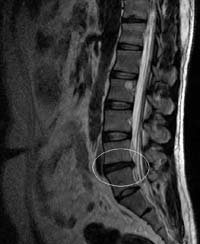The discs located in the spinal column are imperative to the overall functionality of the lower back region. These act as shock absorbers in the areas between the vertebrae. They provide support for the upper body, and they permit movement in all directions.
If a disc becomes herniated, it means that a small fragmented section of the nucleus is pushed out through the means of a rupture or a tear into the spinal canal. In turn, this places an undue amount of pressure on the surrounding nerves and often results in pain and varying degrees of discomfort. If you have a lumbar disc herniation, this guide is for you. Continue reading to learn more about this condition and the rehabilitation that can aid in your recovery.

Lumbar Disc Herniation
The discs are typically spongy and highly pliable; however, as we age and they are subjected to the general wear and tear that occurs with day-to-day activities, they start to flatten out and become hard. This situation is referred to as “disc degeneration”.
When the pressure or the stress is placed directly on the spinal region, the outer ring of the disc may start to bulge, may develop a crack, and may even tear.
When this occurs within the lower back region and a lumbar disc herniation is experienced, the protrusion that develops may then place pressure against the nerve root in the spine. Inflammation may also develop in the region. This, too, may irritate that nerve. Naturally, this will result in pain and varying degrees of discomfort. If you have a herniated disc, a back pain specialist can help diagnose the issue and devise a treatment plan.
Do I Have a Herniated Disc?
What Are the Symptoms of a Lumbar Disc Herniation?
Lumbar disc herniation has the potential to result in immense pain; however, up to 90% of all individuals that develop this issue will often have no symptoms after a month to two months. The following outlines the symptoms that may accompany a lumbar disc herniation:
- Either intermittent or continuous pain in the back. Often, the degree of the pain stems from certain movements. For example, pain may become worse when standing or sitting for long periods of time, after coughing, or even performing simple movements.
- The back muscles of individuals that have a lumbar disc herniation may spasm.
- Many individuals experience muscle weakness within the legs.
- The leg and/or foot on one or both sides of the body may tingle or numbness may be experienced.
- The reflexes may not be as pronounced or decrease in response in the knees and/or the ankles when a person has a lumbar disc herniation.
- Many patients that experience this type of herniation find that the functionality of their bladder or their bowels is impacted by the injury.
- It is not at all uncommon for lumbar disc herniation patients to experience issues with their sciatica nerve. When this occurs, pain develops near the back of the body and/or the buttocks region. It then radiates down through the leg – impacting the individual all the way through the calf and/or the foot region.
- Many individuals describe an “electric shock-like” pain that jars either one side or the other of the body.
- A sufferer may experience lower back pain if they sit or lie in bed for long periods of time.

The symptoms that are experienced with a lumbar disc herniation vary immensely from one person to another. The severity of the symptoms depends on several factors. These include the position of the disc that has experienced a herniation and the size of the disc herniation. Additionally, symptoms that are experienced will depend heavily on whether or not the herniation is in direct contact with a nerve and the amount of pressure that it is placing on that nerve.
Can a Herniated Disc Ever Fully Heal?
According to research, most patients do recover and experience higher levels of comfort, over time; however, it is not so much that the herniated disc has healed. It is more of the fact that the symptoms associated with the lumbar disc herniation improve.
Once a disc is herniated, high levels of inflammation occur. As time progresses, this inflammation actually subsides. This increases the comfort level of a sufferer; however, the crack or break is still present in the outer region of the disc. As a result of this, it may become irritated again in the future.
Many only experience pain and other symptoms during the initial herniation. The following may help in the symptoms of a herniation becoming less:
- When a disc becomes herniated, the body may view it as a foreign body. It may then put up an attack against it, which will reduce its overall size and will eliminate the proteins that result in inflammation. This is a direct response from the immune system.
- Once a disc herniates, it releases water. This will – eventually – be absorbed. Once this happens, the disc will start to shrink. When it shrinks, it may no longer negatively impact the nerve that it is located by in the body.
- Many believe that if a patient performs special types of extension exercises, the part of the disc protruding outwards may then move inwards and away from the nerves within the spine.
In short, no, a herniation in the disc will always remain in the disc; however, if the size of that herniation is reduced, it is less likely to irritate nerves in the spine.
In turn, the symptoms – such as pain and discomfort – will be reduced and the inflammation will go away. This elimination of symptoms is a type of healing, but not a complete healing of the herniation.
Herniated Disc Rehab
If you are reading this, chances are, you have suffered from a lumbar disc herniation. The healing of this issue should not be the main focus. Rather, it should be how to treat and rehabilitate so that your symptoms are eliminated and future problems are avoided.
While it is true that you have surgical options that you may consider, it is best to opt for non-surgical treatments to start with. Most recommend this as the official prescribed course. A herniated disc is considered to be one of the most common of all issues that impact the musculoskeletal system, as well as the spine; however, the treatment associated with a lumbar disc herniation is comprehensive.
In mild cases of disc protrusion, conservative therapy is considered to be appropriate. This typically includes taking analgesics and anti-inflammatory medications. Patients are encouraged to actively engage in a period of rest.
Immediately following this period of rest, patients are typically encouraged to engage in physical activity. Examples of ideal activities include physical therapy and even massage therapy. If pain continues to persist after this therapy, a patient may be encouraged to seek surgical intervention. You may be a candidate for surgical intervention if you meet one or more of the following criteria:
- If you experience radicular-based pain that limits your ability to engage in normal types of activities or if the pain is resulting in an impairment in your overall quality of life.
- If you develop any type of new neurological-based impairments and/or deficits. Examples of these may include numbness and/or weakness of the leg or legs.
- If you find that the functionality of your bladder or your bowel is detrimentally impacted.
- If you find that it becomes very difficult for you to stand or to walk normally.
- Your overall health is considered to be “good”, but the lumbar disc herniation is detrimentally impacting you.
- The use of medications to control or reduce symptoms is ineffective.
- The use of physical therapy herniated disc rehab has been ineffective and is not aiding in your general recovery.

Physical Therapy for Herniated Disc
Physical therapy plays a major role in the recovery from a lumbar disc herniation. If you engage in this type of rehabilitation, you will find that the sessions aid in eliminating pain and discomfort. Additionally, the specialist that aids you during the rehabilitation process will help you learn the process of conditioning your body so that further injuries to the area are prevented.
Many techniques are used in physical therapy to help in the recovery process. Your sessions will start with passive types of treatments.
As the healing starts to occur, you will move to active techniques that will help to continue strengthening the body. The following outlines the passive treatments used in lumbar disc herniation rehab:
- Cold Therapy – This is also referred to as “cryotherapy”. This aids in slowing down the circulation in the area it is utilized on in the body. It also helps in reducing inflammation, pain, and spasms of the muscles.
- Deep Tissue Massage – This places pressure on a region of the body to alleviate spasms and tension.
- Hot Therapy – This helps to increase circulation in a certain area of the body. When blood gathers in an area because of the heat, oxygen and nutrients are also delivered to that area. This aids in increasing the healing process.
- Hydrotherapy – This is water therapy that involves using either a whirlpool or other form of water delivery system. It helps to relax the muscles and also aids in alleviating pain.
- TENS Unit – This is a special type of machine that utilizes a current of electricity in order to stimulate the muscles in the body. Not only does it help in releasing endorphins that will ease pain, but it also alleviates muscle spasms in the body.
Exercises for Herniated Disc
Once your physical therapist believes that you have reached a certain point of accomplishment in your lumbar disc herniation rehabilitation, they will likely move you on to active treatments. This will aid in optimizing your flexibility, increasing the strength of the body, providing a boost to the stability of your core, and improving the movement of your joints.
Your physical therapy rehabilitation will be created based on the severity of your herniation and your individual health. The following outlines active treatments that you may receive:
- Core Stability Exercises – The core of the body is the abdominal region. The muscles in this area help in terms of support for the spinal area. If these muscles are too weak, it will result in an increased level of pressure on the back. Once you are ready, your therapist will walk you through these exercises so that pressure is reduced in the area where your herniation occurred.
- Flexibility Exercises – These exercises will aid in movements, inflammation reduction, and your ability to perform strengthening exercises.
- Muscle Strengthening Exercises – These exercises are designed to help strengthen all of the muscles throughout your body. If you have strength in the muscles, you will have a good support system for your spine. Additionally, you will find that you are more resilient to pain.
- Water Therapy – In this form of hydrotherapy, you may be asked to perform aerobic exercises while in a hot tub or whirlpool. This is an excellent means of conditioning the body without placing a large amount of stress on the body.
When engaging in lumbar disc rehabilitation, the therapist that you work with will aid in teaching you methods for the conditioning and the overall strengthening of the back. This will help in reducing the pain and discomfort that you experience with the herniation. You will be provided with self-care strategies that will help you to better understand the issue in which you suffer and how to treat the symptoms that stem from the condition.
The goal will be to live pain-free without depending on medication or having to resort to surgical interventions. Once the therapy is finished, it is ideal that you continue on your own.
If you live in the Denver area and want to know more about lumbar disc herniation treatment or to set up your rehabilitation, contact us here at Back to Motion Physical Therapy today.

